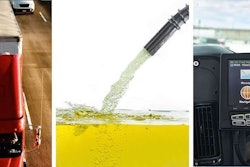I’ll have much more coming from FTR’s Transportation Conference in Indianapolis this week, where speakers have talked the overall economy, freight economy, capacity, regulatory outlook, truck orders and more, but here are a few interesting comments from speakers that have caught my ear.
Check out all the coverage so far from FTR’s Transportation Conference by clicking here.
Driver surplus?
No matter your thoughts on whether autonomous vehicles will stick, increasing vehicle automation is a trend that’s not going away. And if the current trend of automation continues, there could actually be a driver surplus — yes, surplus — sometime in the 2020s, said FTR’s Noel Perry.
Or maybe not:
Werner President and COO Derek Leathers said he sees the recent interest of late in autonomous vehicles as an “arms race” by the OEMs. He compared truck makers’ quest to become the first to introduce a highway-legal automated truck to the race by superpower countries to be the first to the moon in the 1960s.
He doesn’t foresee a completely driverless truck rolling down the highway in our generation, he says.
Pay’s not the only answer to driver recruiting:
“It’s going to be harder and harder to do it (driver recruiting and retention) with just money,” said Leathers during the same panel discussion.
Driving a truck “is still a tough job,” he said. “Infrastructure is crumbling. Parking is worse than it’s ever been. It’s getting harder and harder to get folks to enter this line of work.”
E-logs: One strike, you’re out?
How will the Federal Motor Carrier Safety Administration enforce the upcoming electronic logging device mandate?
It’s still a mystery, said former FMCSA Administrator Annette Sandberg, saying she could see it as a “one strike and you’re out” policy.
“It’s a mandatory regulation,” she said, meaning enforcers likely will drop a carriers’ safety rating to Unsatisfactory, giving them 60 days to comply with the rule or be shut down. “A two-truck carrier might be able to do that,” she said. “But a fleet with 2,000? Not a chance. Some carriers will just throw up their hands and sell to somebody already on it. I suspect that’s what’s going to happen.”
Veterans dig automatic transmissions:
Though automated-manual transmissions may offer an easier path to getting new entrant drivers into the industry, there are benefits to veteran drivers too, says Leathers, despite their resistance to switching away from traditional manual transmissions.
Werner allows its veteran drivers to test drive trucks equipped with automated-manaul transmissions for two weeks, with no commitment to continue to use the truck, “as long as they try it for two weeks,” Leathers said.
The retention rate? 90 percent, he said, decide to stick with the AMT than go back to a manual transmission.













